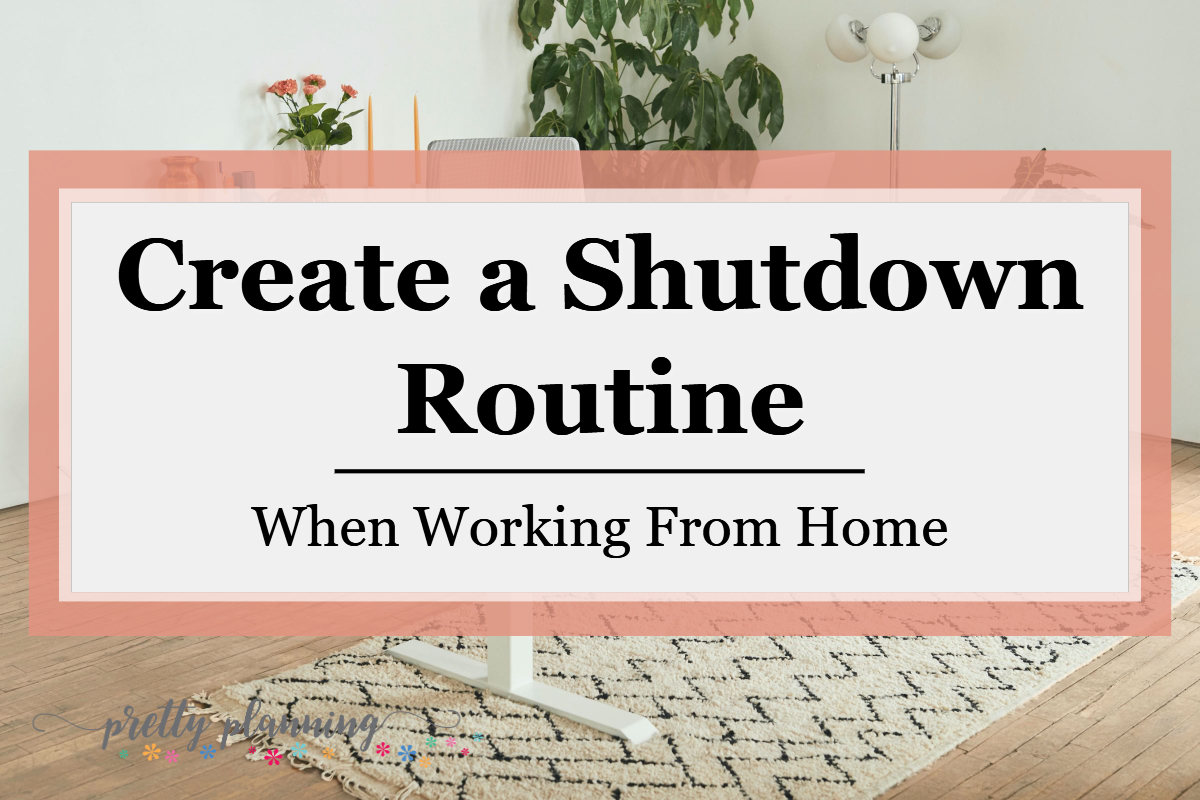End Your Day with a Shutdown Routine When Working from Home

When you work from home, it’s easy to blur the lines between work time and personal time. Without a clear transition, you might find yourself checking emails at 9 PM, thinking about unfinished tasks while watching TV, or feeling like you never truly "clock out."
That’s why you need a shutdown routine.
A shutdown routine is a set of intentional steps that signals the end of your workday. It helps you mentally detach from work, relax, and prepare for a fresh, productive tomorrow.
The best part? It doesn’t have to take long! Just 15–30 minutes of intentional end-of-day habits can help you leave work behind and enjoy your evening guilt-free.
Here’s how to build a shutdown routine that works for you.
Do a Final Check-In on Your To-Do List
Before you log off, take a few minutes to review what you accomplished and what’s left. This helps you feel a sense of closure and ensures that no important tasks slip through the cracks.
✔ Check off completed tasks - Celebrate what you got done!
✔ Move unfinished tasks to tomorrow’s list so you’re not stressing about them all night.
✔ Jot down any last-minute thoughts or reminders - this clears your mind before you disconnect.
Example: Instead of thinking, “Did I forget something?” all evening, you end your workday knowing exactly what’s waiting for you tomorrow.
Plan Tomorrow’s Priorities
A productive tomorrow starts tonight. By setting your top priorities before you finish work, you can start the next day with clarity and focus.
✔ Choose your top 3 priorities for the next workday.
✔ Time-block important tasks in your planner or digital calendar.
✔ Gather any files, notes, or materials you’ll need so you’re not scrambling in the morning.
Example: You write down:
✅ Finish client proposal (9–11 AM)
✅ Respond to important emails (11:30 AM)
✅ Outline new blog post (2 PM)
Now, when you start work the next day, you already know what to focus on.
Organize & Clean Your Workspace
A cluttered desk can leave you feeling frazzled and disorganized, while a clean workspace makes it easier to start fresh the next morning.
✔ Tidy up your desk - Put away papers, notebooks, and coffee cups.
✔ Close all work-related tabs and apps - Seeing them later can tempt you to check emails!
✔ Set up your workspace for tomorrow - Place your planner, laptop, or to-do list where you can easily grab them.
Example: You take five minutes to clear off your desk, push in your chair, and shut down your laptop. The next morning, you’re greeted with a fresh, inviting workspace instead of yesterday’s mess.
Shut Down Your Computer & Work Apps
Leaving your work email open or getting Slack notifications in the evening makes it way too tempting to check in "just for a second" - which turns into another hour of work.
✔ Log out of work accounts on your phone (or use a work profile that you can disable).
✔ Turn off notifications for work emails and messaging apps.
✔ Physically shut down your laptop instead of just closing the lid - this signals a real stop to your workday.
Example: Instead of hearing a Slack ping at 8 PM and feeling obligated to respond, you fully disconnect - because your workday is officially over.
Create a "Commute Replacement" Transition
When you work in an office, your commute acts as a natural transition between work and home. But when your office is at home, you need to create a new transition ritual to signal the switch.
✔ Take a short walk outside, even just around the block.
✔ Change into comfortable clothes - Yes, even if you wore sweatpants all day!
✔ Do a quick workout or stretch to release tension.
✔ Listen to a podcast or music to shift your mindset.
Example: Instead of going straight from answering emails to making dinner, you step outside for a 10-minute walk to clear your head and officially "leave work."
Set Boundaries with a Work Cut-Off Time
One of the biggest challenges of working from home is knowing when to stop. If you don’t set a work cut-off time, you might keep working into the night, leading to burnout and fatigue.
✔ Decide on a firm work stop time and stick to it.
✔ Communicate your boundaries with coworkers or clients if needed.
✔ Resist the urge to check emails after hours - nothing is as urgent as it seems!
Example: You set a hard stop at 6 PM. Even if you feel tempted to do "just one more thing," you remind yourself that rest is productive too.
Do Something Relaxing to Unwind
Ending your day with a calming activity helps you mentally separate work mode from personal time.
✔ Read a book, watch a show, or listen to music to decompress.
✔ Cook a nice meal or enjoy tea to slow down.
✔ Practice mindfulness - deep breathing, meditation, or journaling can help you relax.
Example: Instead of scrolling your phone while still thinking about work, you light a candle, make a cup of tea, and read a book - a much better way to unwind.
A Shutdown Routine = Better Work-Life Balance
A strong shutdown routine helps you:
✅ Mentally detach from work
✅ Feel accomplished and prepared for tomorrow
✅ Create clear boundaries between work and personal life
✅ Enjoy your evenings without work stress lingering in your mind
Here’s Your Simple End-of-Day Routine:
✔ Review your to-do list & set tomorrow’s priorities
✔ Organize your workspace so it’s ready for a fresh start
✔ Shut down your computer & log out of work apps
✔ Create a "commute replacement" transition
✔ Stick to a work cut-off time to protect your evenings
✔ Do something relaxing to unwind
By making these steps a habit, you’ll leave work behind at the end of the day - so you can fully enjoy your personal time without guilt or stress.
